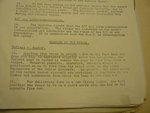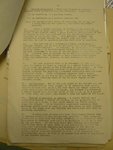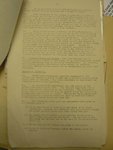Glider
Major
The problem we have is that the role of the Defiant was to fight fighters and bombers, in combat you cannot pick and choose as the bombers are escorted by fighters.Yep, you are absolutely right, they were right to doubt; the thing is, the Defiant was not designed for the purpose of attacking single seat fighters, but it was employed in that role. Hence my comment about misappropriation of resources in another thread. Yet, despite a couple of bad days (264 Sqn suffered six shot down on one day too, but no lesson was learned) the Defiant continued to be used in a role it was not designed for. Clearly as these documents show, there was doubt about its speed in the face of the enemy, yet apart from Sqn Ldr Hunter's efforts, nothing was done officially to change its tactical use in the battle. This is not the fault of the aircraft, as obvious as that statement is.
I dont think my comment was an exageration. 14 losses in 174 sorties is an 8% loss ratio and that is very high. If as is likely some of those sorties didn't involve combat, then the loss rate would be through the roof.Bearing this in mind, the Defiant did not do anywhere near as badly as is always assumed. Your statement of "loss rates through the roof" is a bit of an exaggeration considering only 14 aircraft were lost in combat in those 174 sorties, regardless if they were all combat sorties or not. Read my earlier post; on papr it looks worse than actual numbers suggest, but 14 lost in a month is not comparitively high losses at that time. As a percentage of a single squadron, yep - looks real bad on paper.
Look at it another way Many RAF squadrons flew three missions a day. Assume 12 planes a mission you would lose the squadron in a week at an 8% loss rate.
This is where we disagree, any fighter in the front line had to face anything that came its way. You cannot and should not pick and choose. In theory the Hurricane was targeted against the Bombers but they fought fighters as often as they fought bombers.Yes, I agree with you that the Defiant should not have been used in the roles it was, convoy escort, standing patrols
Losses for Defiants were much higher than Hurricane or Spitfire squadrons in a percentage of losses vs sorties. Actual combat proved that.,My second point is that losses of Defiants were not as high numerically as assumed by comparison to other types and the type fared better than you give it credit for. Yes it was slower than single seat fighters, but no more vulnerable than any other fighter if the tactics 264 Sqn employed were used. Actual combat proves that.
Small point but the official tactic for the Defiant was to use them in groups of four. It was the Squadron Leader who insisted on flights of three.Regarding Sqn Ldr Hunter's reluctance to follow the official line - why would he? the tactics Defiant crews were trained to use against bombers clearly wouldn't work against fighters! His actions saved the lives of his squadron mates! Almost all RAF pre-war tactics were found wanting once the shooting started - squadrons were left to their own devices to adopt tactics based on their experiences, this is why Sailor Malan put out his Ten Rules of Air Fighting; this wasn't an edict from up above, this was a commander concerned about the high losses his troops were suffering. Again, the reason why RAF units adopted the Finger Four formation was because combat experience that proved that the Vic formation was unwieldy. This is also why indidivual airmen synchronised their guns to meet at a much closer range than what was officially specified and fitted armour plating behind their seats. These didn't come from official sources.
I attach the combat trials which I hope you find of interest, I also hope you can read then because they are dreadful copies.Interesting documents though Glider, thanks for sharing. Since I am in New Zealand it's kind of hard for me to gain access to material about the Defiant from official sources. I am keen to get hold of documents that outline when and why (yes, I know why, but offically) the Daffy squadrons were withdrawn from day ops.



